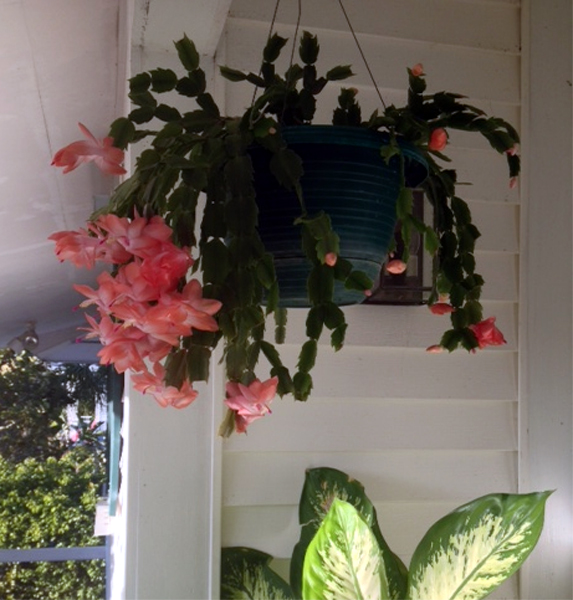We began to hear loud, pretty singing coming from birds on our upper front deck. They appeared to be checking out the area for their new "digs." Many of us are familiar with birds nesting in our hanging plants. If they are allowed to do so, it could require sacrificing the plant since it cannot be watered as usual. I attached a few pieces of aluminum foil on the planter. Birds see their reflection in the foil and this usually leads them to seek out another location. These darling little Carolina Wrens with their huge voices were not to be deterred from their ultimate destination which was my favorite peach colored Christmas Cactus.
Christmas Cactus
We watched from our sidelight windows inside as they carried their building materials to their "nest." Gradually, we became "trusted" neighbors. We could sit on the deck and watch them fly back and forth. From indoors, we could climb on a chair and look out the sidelight into the nest. There was only ONE egg. It was totally amazing to watch all the attention and feeding that went into that single baby bird. They fed the little fellow all day long. We expected him to emerge from the nest as a "plump chicken!"
Carolina Wren
As the day approached for leaving his nest, there was a lot of action. We realized the "big day" had arrived for fledging. We missed seeing him fly off, but were aware it had happened. The great news was that we had all became good neighbors and the Christmas Cactus is alive and well. Best of all, our feathered friends have begun visiting us again.
Watering the cactus with a plastic mustard type container with a spout worked well as I could direct the water in order that it would not touch the nest. This works very well for many plants, especially African Violets whose leaves do not like to be wet.
There is a special video on You Tube of the cute little Carolina Wrens entitled "Carolina Wrens From Birth to Fledging." Your Grandkids would enjoy it....so will you.
Patti P.

